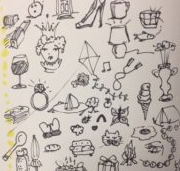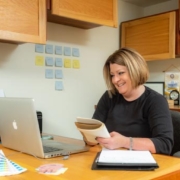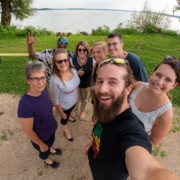
I realize I’m posting at a less than optimum time from a business standpoint. But maybe you are checking your social media today, and it seems like an appropriate time to talk about giving. Maybe you’re finishing up your 2019 goals — adding a picture to your vision board or sticking notes up to remind you of good habits for the new year.
I was watching “Good Morning America” just now and they had a super segment on giving. Wharton Professor Adam Grant’s book, Give and Take, talks about “The Five Minute Favor”. So, you spend five minutes a day crafting a thank you, writing a book review, recommending a peer on LinkedIn. You do something to help someone else out.
Two of the professional groups I’ve been involved in, BNI and Rotary, have tag lines that boast the benefits of giving:
- BNI: Givers gain.
- Rotary: Service above self. They profit most who serve best.
People remember you when you help them. So give your time and knowledge. And if you want to know more about what goes into designing a logo, contact me. I’m happy to share!
Collaborating with a graphic designer guarantees proper use of your logo/brand. And there are 3 ways we can work together.

1. Existing Brand
Many clients I work with already have a logo and graphic standards document. I’m okay with this! And I’m very sensitive to the idea of consistency. It’s important for us to use our logo in a way that keeps it legible and clear. You don’t want it placed over a photograph or distracting background. You never want to change the color or font in your logo. These may seem like common sense tips, but you’d be surprised how many times I’ve seen established companies use their logo in one of these ways. Collaborating with a graphic designer guarantees proper use of your logo/brand. Here is a great post on how inconsistency can cost you.
2. Refresh Brand
Sometimes companies are worried about changing their logo. They’ve had it a long time, and they have a lot of equity in the look and feel. But maybe the font is a little dated; the color might be out of style. This is where a little refresh comes in handy. You don’t have to completely change the look of your logo to bring it up to date.
3. Complete Rebrand
This is the most fun of all. It could be a new company. It could be an established company that is changing direction on products or services. I will work with your marketing department to make sure the creative direction follows the mission of the business. I love to ask questions like: what do you want people to think about you? Who is your target market? What kind of feeling do you want people to get when they see your logo/brand?
There are many ways a graphic designer can help you. From a clean sales slick to classy product packaging. If you have questions about what your company needs, contact me. There’s nothing a cup of coffee and a conversation can’t tackle.

Face-to-face, phone or email: I’m often given the choice. And I always opt for in-person meetings when possible.
95% of people say that face-to-face meetings are essential for long-term business, building trust and encouraging strong relationships.
(Source)
Three reasons why face-to-face is better:
1. Your personality shines through.
Your passion for your work shows. Facial expressions, hand gestures, eye contact…the things that make you a good communicator…are more obvious in person.
2. Some people communicate better in person.
I can’t see you when we’re on the phone (unless we’re using a video conference platform). When you live and work in the same city as your clients, meet with them! It’s much easier to see their reactions to ideas in person.
Some people don’t like the phone.
They’re unable to really discuss a project like they could if you’re sitting right there with them. They can show you what they’re talking about.
And email can really be difficult.
A simple question? Email is great. Needing clarification on a project, or having a problem with the direction a project is going — this warrants at LEAST a phone call, if not a personal meeting.
3. Having visuals helps reinforce the assignment.
My biggest road blocks have come from trying to execute a project without a great creative brief and a meeting. There is a disconnect.
When my clients have examples of things they like (or don’t like!), their direction is clearer. Verbalizing is sometimes okay. But if I can see it, pick it up, feel the paper, flip the pages, it makes it easier.
If you are looking for a graphic designer, contact me and let’s sit down together to discuss.
 Project updates are one way I educate my clients and business associates on what I do. I might start my 60-second at my networking meeting with, “Today, I have these tasks on my to-do list…”. It gives people an idea of the range of products I work on.
Project updates are one way I educate my clients and business associates on what I do. I might start my 60-second at my networking meeting with, “Today, I have these tasks on my to-do list…”. It gives people an idea of the range of products I work on.
Current Work
What are you working on right now? Maybe a company rebrand? Or are you updating your website? Perhaps creating new social media graphics for your social media channels?
My Project Updates
The past month has me:
– wrapping up a newsletter for one client
– creating food labels for a collaborative effort of two local companies
– creating a corporate brochure for a client that specializes in large mailings
– developing print materials for my new brand
Self Promotion
See how self-promotion is last on the list? That’s what seems to happen. As soon as I start working on my own brand, I get busy with client work. When I look at my website and see that my 30-day drawing challenge flopped early in the game. Finding time to do anything “extra” is tough.
Projects In the Groove
So I turn to the wisdom of the late great Steven Wright: “I was trying to daydream, but my mind kept wandering.” I can always tell when I’m in a groove because time flies. A project that could take days wraps up in a few hours when I’m in my groove. This creative energy doesn’t happen on command. It’s the kind of energy that shows up after a vacation. Your mind is open and free of all the overwhelming onslaught of information.
Thank You
During this week of Thanksgiving, I am thankful that my work continues to be something I enjoy. I have great clients, and, most of the time, they give me creative freedom. They appreciate fresh ideas. If you’re looking for fresh ideas, contact me. If you’re already a client, my personal thanks go out to you for the work!
As a graphic designer, I have the opportunity to use stock photography or custom photography. Sometimes stock images are enough, but when you are able, professional custom photography is the way to go.
Whether you are building a website, developing a brochure or creating art for your business, you have a choice.
Here are three reasons why professional custom photography is better:
1. You can talk to the person responsible for the photography.
I like to work directly with writers, printers, illustrators and photographers. It is best to meet and discuss the project, because you can show examples of what you like (and don’t like). And that means they have a visual of what you are looking for.
2. You can see what the custom images will look like.
Most photographers are working with digital cameras now. It’s nice to be able to see what the pictures will look like while you are taking them. There might be something that you’ll catch during the shoot; for example: a wrinkle in a shirt; hair out of place; an odd reflection. And if you catch these during the shoot you won’t have to retouch later.
3. You’ll never see your images anywhere else. They are yours.
Custom photography means you get exactly what you want. So, when people see your website or brochures, they will know it’s custom. If it’s stock photography, it’s usually pretty obvious.
I used Kyle Wege with Crimson Sun Studios for my new website. We are friends and see each other every week in our referral group. Your photographer should ask how your images will be used. They should know what the lighting is like where you will be shooting. And they should make you feel comfortable whether they are taking your portrait or capturing product images.
If you are looking for photography, contact me and I will help you find the right fit for your photography needs.
I’ve belonged to several networking groups, and I have found you get more out of the time you spend outside business referral group meetings. Coffee, lunch, drinks…it’s more casual. I’ve included 3 tips for productive networking below.
I aim to connect with three new people and set up meetings with them over lunch or coffee. If you wind up hanging out with the friends you already know, it’s pretty much a social. If you ask those friends to introduce you to people you don’t know, that makes it productive.
Eleanor Roosevelt said her private, relaxed gatherings were conducive to productive meetings. You learn a lot when you’re in a more low-key setting. You feel free to talk — share common interests. Those conversations create connections, trust and loyalty.
Recently, in one of my morning meetings, the energy was really high. People were chatting it up when the president finally called the meeting to order. We had a social planned for that evening, and the buzz about that social had us all happy and ready to face the day, knowing we had something fun to look forward to.
Here are three tips for productive networking:
1. When networking, ask people you know to connect you with new people.
It’s okay to hang out with your friends and business associates. And this is the perfect time to ask them to introduce you to their friends and business associates.
2. Connect with three new people and schedule time with them.
Make it a goal to meet three new people. Send a followup email or call and invite them to meet. Follow that up with a thank you, even if it’s via messaging. (A handwritten note is special.)
3. Spend your time doing what you enjoy.
Schedule meetings doing things you enjoy: a drink at your favorite watering hole, a walk by the lake, bowling! Meeting in an office or conference room has its place, but nurturing a new relationship should be fun. Doing things you enjoy will bring out the best in you. And your new acquaintance will get to know the real you.
We need to work, but we can make that work more enjoyable by being creative and including elements of fun. Isn’t that what life is about? Figure out your passions, the things that make you happy, and put those passions into your daily life. Contact me if you like to bowl or if you want to talk about your next design project!
Thanks to Crimson Sun Studios for the sweet picture!
What is an annual report?
Here is Merriam-Webster definition of an “annual report”: a usually lengthy report issued yearly by an organization giving an account of its internal workings and especially its finances. This sounds pretty bland, doesn’t it? An annual report can be more than an official account. It can be something people want to look at. Especially if your annual report design is done by a professional.
What does an annual report look like?
Graphics, typography, color and texture come together to create an attractive useful report. But it doesn’t have to be printed: it can be an interactive pdf or a video folder. By the way, this is one of the newest approaches to marketing collateral: an LCD screen with control buttons is embedded into a physical printed folder!
If the report is printed, the paper options are endless. And paper can make a huge impact on the final product.
How do you produce an annual report?
Graphic designers take the essence of a company and make it look good. It also happens to be one of the most challenging and rewarding opportunities for a graphic designer. Of course, starting out with lengthy copy documents, spread sheets and folders of images is daunting for any communications team. If you bring a graphic designer in early on the project, they can help determine a direction. For example: number of pages, digital or print (or both), photography and illustration needs. And these are issues graphic designers deal with on a daily basis. So they can guide you and connect you with the right resources.
I have experience with annual report design. I thoroughly enjoy it. If you have questions about annual report design and production, call me at 608-206-0469, or shoot me an email. Let’s have a conversation and see if we are the right fit.



